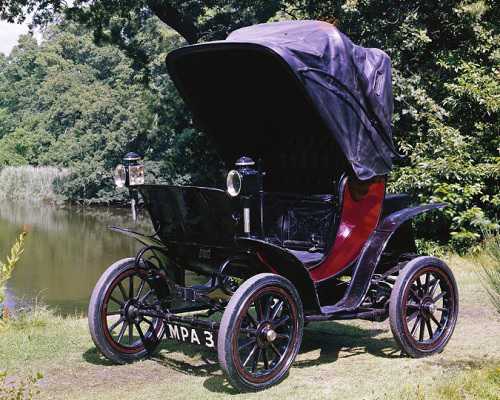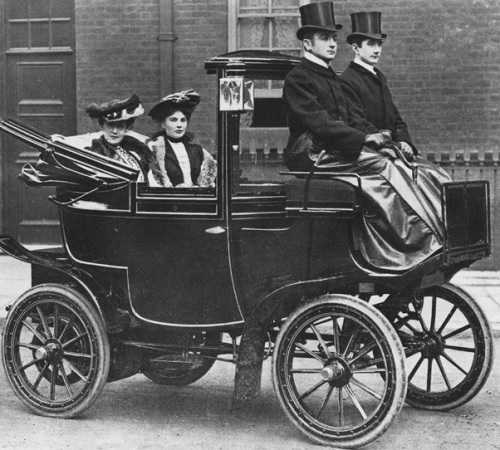The decade from 1900 to 1910 represented the Golden Age of electric cars. In the first year of the new century, nearly 40 per cent of the cars sold in the United States, the world’s largest market, were electric. Gasoline-powered cars accounted for just 22 per cent.
Although development of the internal combustion engine was progressing swiftly, and manufacturers like Jenatzy and Jeantaud were well aware of the threat they posed, the electric car still held the upper hand, particularly in ease-of-use and refinement. The majority of car journeys took place in built-up areas, so early drivers had no range anxiety worries.
Electric cars had already seen off the challenge of steam-power, which required drivers to keep a close eye on the pressure gauge and needed regular top-ups to keep going.
The limited range of electric cars would only become an issue when smooth roads were built to link towns together – making longer trips not only viable, but also desirable. In 1900, routes outside urban areas were generally in poor condition and unsuitable for early automobiles of whatever persuasion.
Electric cars were also easier to drive. Manual transmissions of the era were sticky and difficult to master because they used straight-cut gears and had heavy clutches. Electric vehicles offered a largely fuss-free solution for pioneering motorists because they had no need of complex transmissions. They were relatively advanced, reliable and well-liked.
‘The electric automobile is managed easily, is docile, has a noiseless motion and the motor itself is mounted in a very simple manner,’ wrote The Automobile in 1905. ‘Over petrol cars it has the advantages of easier starting, greater cleanliness and, perhaps, lower cost of upkeep. There is but little vibration with the electric automobile, no bad odour, and no consumption of energy whilst the car is stopped.’
Drawbacks? ‘The inconveniences of electricity as automobile motive power are increase in dead weight carried, maintenance and renewal of accumulators. These… are lessened greatly in cars for town work.’
In May 1900, The British Daily News proclaimed electricity to be the future for automobiles. ‘One cannot help thinking that the automobile carriage is destined to produce a change in the customs, character and ideas of society similar to that which the [replacement] of the stagecoach by the railway brought about,’ began a report from the World’s Show, held in Paris. ‘Here [in Paris], for instance, is a comfortable, handsome carriage, seated for four people, and capable of doing nearly 40mph. [However] the family parties must be few who would care to fly over a country road at the rate of an express train. Half that speed might well content them.

‘Of the four-wheeled variety of large electric carriage there are several examples, lightly and strongly built, tastefully designed, provided with hoods, splash-boards, footman’s box and all the necessary apparatus. The guiding instrument (the steering) is placed on the right-hand side of the carriage.’
The paper was in no doubt electric cars would soon be good enough to tour Europe, replacing the traditional stagecoach-and-horses. ‘[The automobile] needs no horses, and it is cheap,’ it went on. ‘Your electric machine, of course, gets exhausted after a time, and must be replenished, but it never is tired and never needs a doctor.’ For this prediction to come true, though, there would have to be established ‘here, there and everywhere’ depots for the supply of electrical energy.
Dozens of manufacturers sprang up to satisfy the demand for electric cars. Some, such as Oppermann, of London, Steinmetz of Baltimore, and the unlikely sounding Swiss company Triblehorn, only produced a small number of vehicles before they went bust, were taken over or gave up. Others, such as Columbia, Baker, Waverley, Studebaker, Rauch and Lang and Milburn, were among the largest motor manufacturers of the day. A few, like Lohner and Pieper, pioneered technology that would be refined by Toyota for the Prius hybrid nearly a century later.
All of these car manufacturers had two things in common: they were sure that electrical power was the future and that a breakthrough in battery technology was ‘just around the corner’.
Indeed, by 1901 the electric car had become the first choice of Royalty. In 1896, the British company Thrupp & Maberley had built an electric ‘carriage’ for the Queen of Spain. Jeantaud received orders from Prince Strozzi, in Milan, the duchess of Alva, in Madrid, and Prince Galitzin, in St Petersburg.
In Britain, Queen Alexandra took delivery of her first car in May 1901, from the City and Suburban Electric Carriage Company of Denman Street, Piccadilly Circus, in London. Edward VII’s wife had the ‘Electric Votiurette’ shipped to Norfolk where she used it as her personal transportation in the grounds of the royal Sandringham estate. She even taught herself how to drive.
Reporting the Queen’s first drive, The Evening Post remarked:
Anything less like a Royal carriage it would be difficult to imagine. The floor level was several inches above the tops of the 28-inch wheels, and the vehicle looked top heavy and unsafe. There was no wind-screen, and practically no dash, but an enormous leather hood afforded moderate protection in bad weather.
Autocar was somewhat kinder. ‘We understand that Her Majesty is in the habit of driving the vehicle herself, and is delighted with the ease and simplicity of control and manipulation,’ it wrote on 25 May 1901.
The Queen’s two-seater was luxuriously appointed. It was upholstered in dark green leather with a folding hood of polished grain hide lined with a dark green cloth. The black bodywork was highlighted with red pinstripes and the dashboard was also trimmed with patent leather. It rode on bicycle pattern wire-spoked wheels with 3-inch pneumatic tyres and weighed, together with the batteries, 12cwt (612kg). According to Autocar, Her Majesty’s car had a top speed of 12mph (19km/h) and a range of 40 miles (64km). Although the price isn’t known, The Star newspaper stated on 27 September 1901, that: ‘From a perusal of the builders’ catalogue, such a vehicle could not be duplicated under a cost of £400’.
The Queen was so pleased with her choice that a couple of years later her son, the Prince of Wales (later to become King George V), acquired a town brougham, also manufactured to special order by City and Suburban. This vehicle benefited from developments in battery technology, which gave it increased capacity, a better range and a top speed of 16mph (25km/h).
Queen Alexandra’s car was used by City and Suburban for publicity purposes, including an appearance on its stand at the 1901 show at the Agricultural Halls, in London. Thanks to royal patronage, the company reported that it had ‘a number of orders in hand from members of the nobility of both sexes’.
Indeed, it had built a new seven-storey works in the heart of London’s West End to sell, house and service its cars. The impressive 19,000ft2 (1,765m2) building, in Denman Street, close to Piccadilly Circus, had space for more than 100 electric carriages. The firm offered a premium service to wealthy clients similar to the horse-drawn carriage companies of the day. It not only sold electric cars outright, but for an annual fee of between 12 and 25 guineas, depending on the size of the vehicle, held them in storage, undertook all regular maintenance and took care of charging the batteries.
An article, written for the 1901 Automobile Club Show, explained the door-to-door service:
The cars will be run round to the house of the owner immediately on receipt of a telephone message, and will be run back to the station when the owner alights, fresh accumulators [batteries] put in, or fresh charge, as may be necessary. In the case of the theatre, the cars will not wait outside the theatre; the station will have notice when the piece is nearly over, and the car will be run round, or it can be had by telephone at any time. The charge is uniform for all sizes of vehicles and for all classes of users. The company propose to open depots wherever trade allows.
The state of Britain’s earthen roads was a source of royal consternation, however. Apparently, the dust kicked up by Queen Alexandra’s car left Her Majesty in need of a good bath after every drive. As a result, the King and Queen decided they could only use the car when the roads were damp, which led to some hilarious attempts to solve the problem.
The Evening Post of Saturday, November 6 1926, reported:
Numerous patents were taken out, the most popular idea being to fit a large water-percolator on the back of a car. Some inventors were quite blind to the fact that dust was raised by air disturbance as well as by tire friction, and proposed to end the trouble by damping pads of absorbent material which should rest lightly on the tires, keeping the rubber mildly moist. Others regarded the problem as insoluble, and were content to suggest huge horizontal screens behind the car.
Luckily for other road users, none of these crazy suggestions went beyond the patent stage.
City and Suburban manufactured vehicles under license from an American company – the Electric Carriage Company, of Hartford, in Connecticut – one of several that had made up the empire of Colonel Albert Augustus Pope. Although based on the popular Columbia design, in the UK they were mainly fitted with British-built bodies.

City and Suburban were popular with the upper-classes in London but the best-known British marque at the turn of the century was Electromobile, in Lambeth. Rather like City and Suburban, Electromobile licensed a foreign design – in this case a French front-wheel drive vehicle manufactured by Krieger – before refining the concept for British customers. The London-based company ditched front-wheel drive in favour of a motor in each rear wheel. This complex system was simplified for 1903 with a single motor mounted on the rear axle.
Limited sales led Electromobile to pursue a contract-hire scheme – although at an annual cost of £325 for a brougham (including batteries and maintenance) it was still beyond the reach of all but the very wealthy. Eventually the company gave up and moved into the London electric taxi business that had been recently vacated by Bersey. Its cabs continued to run well into the 1920s, long after demand for electric cars in Britain had dried up.